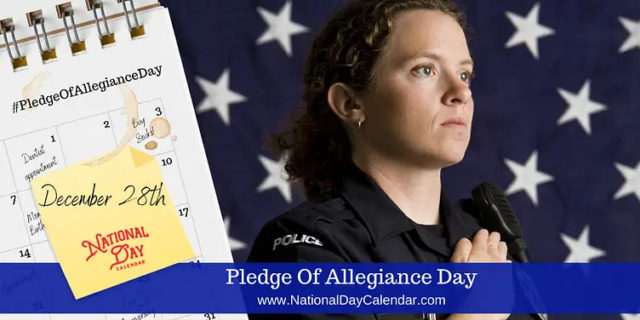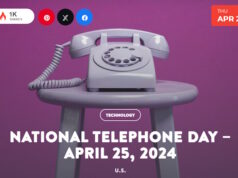
Pledge of Allegiance Day on December 28th commemorates the date Congress adopted the “The Pledge” into the United States Flag Code.
“I pledge allegiance to the flag of the United States of America and to the Republic, for which it stands, one nation, under God, indivisible with liberty and justice for all.”
- The Pledge of Allegiance wasn’t the first pledge of allegiance. That honor rightly belongs to a simple version created by Civil War veteran Colonel George Balch, who composed it in 1885.
- Balch, who worked for the New York Board of Education and for a time served as governor of the Philadelphia Naval Asylum, was dedicated to teaching immigrant children loyalty and devotion to their new country. His pledge read: “We give our heads and hearts to God and our country; one country, one language, one flag.”
- Balch’s version was adopted by a number of schools, the Daughters of the American Revolution and the Grand Army of the Republic, (whose museum is in Philly), and persisted until the National Flag Conference of 1923.
- Francis Bellamy receives credit for writing the Pledge of Allegiance. The Youth’s Companion, a magazine for young people, first published it anonymously on September 8, 1892, under the title “The Pledge.” It was written in celebration of the 400th anniversary of the discovery of America.
- Francis Bellamy reportedly wrote the Pledge of Allegiance in two hours, but it was the culmination of nearly two years of work at the Youth’s Companion, the country’s largest-circulation magazine.
- In a marketing gimmick, the Companion offered U.S. flags to readers who sold subscriptions, and now, with the looming 400th anniversary of Christopher Columbus’ arrival in the New World, the magazine planned to raise the Stars and Stripes “over every Public School from the Atlantic to the Pacific” and salute it with an oath.
- The pledge was to be recited in unison by school children as a salute to the American flag.
- In 1923 and 1924, the National Flag Conference inserted the text of the pledge into legislation. Though modifications were made, the pledge remained nearly the same. At the same time, the conference didn’t designate it as the official pledge. In its original form, it read:
- “I pledge allegiance to my Flag and the Republic for which it stands, one nation, indivisible, with liberty and justice for all.”
- The small changes resulted in this version:
- “I pledge allegiance to the Flag of the United States of America and to the Republic for which it stands, one nation, indivisible, with liberty and justice for all.”
- On Flag Day in 1954, Congress added the words “under God” in response to the anti-Communist opinion sweeping the country during the Cold War.
- Congress formally gave recognition for the Pledge of Allegiance on December 28, 1945.
- James Upham invented a salute to accompany the pledge: Kids would place their right hands over their hearts, then stretch out their arms and raise them, palm downward, toward the flag. During World War II, the second part of this salute was dropped like a hot potato because of its resemblance to the Nazi salute.
- Those two little added words, “under God”, set off a cascade of court cases.
- A 1940 Supreme Court ruled that public schoolchildren who objected to the Pledge on religious grounds could be compelled to recite it.
- Three years later, the Supreme Court reversed its decision, holding that the First Amendment protected the right of students not to recite the Pledge.
- A later court decision by the 11th Circuit Court of Appeals held that students should not be required to stand for the Pledge since standing (or not standing) is a form of free speech.
- Today, 46 states require public schools to make time for the pledge—just Vermont, Iowa, Wyoming and Hawaii do not.
- It’s a daily order of business for the U.S. Senate and House of Representatives. And hundreds of thousands of newly minted citizens pledge allegiance each year during the U.S. naturalization ceremony.
- The snappy oath first printed in a 5-cent children’s magazine is better known than any venerable text committed to parchment in Philadelphia.
- In 1982, Congress received a submission for National Pledge of Allegiance Day, but they took no action.
- In 2004, the Senate passed Resolution 378 designating June 14, 2004, as National Pledge of Allegiance as a way to reaffirm the United States flag as a unique symbol of the United States and its ideals.
Sources:












